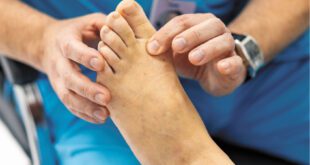 November is Diabetic Eye Disease Awareness Month, drawing into focus how diabetes impacts the risk of developing certain eye diseases. Understanding these risks and being proactive in your own care can make a big difference in preventing, delaying and managing diabetic eye disease. First, let’s look at the various eye conditions that can affect those with diabetes.
November is Diabetic Eye Disease Awareness Month, drawing into focus how diabetes impacts the risk of developing certain eye diseases. Understanding these risks and being proactive in your own care can make a big difference in preventing, delaying and managing diabetic eye disease. First, let’s look at the various eye conditions that can affect those with diabetes.
WHAT IS DIABETIC EYE DISEASE?
Diabetic eye disease isn’t a single disease, but rather refers to a group of eye conditions that include:
1. Diabetic Retinopathy – The most common form of diabetic eye disease, diabetic retinopathy occurs when high blood sugar levels damage the blood vessels in the retina, which is the light-sensitive tissue at the back of the eye. In its early stage, called nonproliferative retinopathy (NDPR), weak blood vessels in the retina may leak, causing swelling of the macula, the part of the retina that processes central vision. In its advanced stage, proliferative retinopathy (PDR), new and abnormal blood vessels emerge. These vessels are fragile and prone to bleeding, which can damage vision.
Roughly 1/3 of people with diabetes can develop diabetic retinopathy, making it the #1 cause of blindness among working-age adults. Early diagnosis and intervention are crucial to preventing vision loss.
2. Diabetic Macular Edema (DME) – DME is a result of diabetic retinopathy, where fluid builds up in the eye, including under the macula, causing it to swell and thicken, distorting central vision. Central vision is needed to read, drive, watch TV, even recognize faces.
3. Associated Eye Conditions
. Cataracts – Although anyone can get a cataract, people with diabetes are 2-5 times more likely to develop them, often at an earlier age than non-diabetics.
. Glaucoma – Diabetes can double your risk of developing open-angle glaucoma. Having high blood sugar also increases the chance of developing neovascular glaucoma, wherein new, weak blood vessels in the eye block the drainage system, placing pressure on the optic nerve. In addition, having proliferative diabetic retinopathy is a leading cause of this vision-robbing disease.
WHAT ARE THE SYMPTOMS OF DIABETIC EYE DISEASE?
What’s particularly frightening about diabetic eye diseases is that in their early stages, they often produce no symptoms at all. Once they progress, however, they can cause symptoms like:
. Blurred vision
. Spots or dark strings floating in vision (floaters)
. Dark or blank areas in vision
. Difficulty distinguishing colors
. Vision loss
WHAT CAUSES DIABETIC EYE DISEASE?
The main cause of diabetic eye disease is prolonged high blood sugar levels, which damage retinal blood vessels. Things that increase your risk of developing one or more of these diseases include: having prolonged diabetes, poor blood sugar control, high blood pressure, high cholesterol, and smoking. Being Black, Hispanic or Native American also increases this risk.
PREVENTING AND MANAGING DIABETIC EYE DISEASE
You can reduce your risk of developing diabetic eye disease, and slow its progression by following these guidelines:
1. Get Regular Diabetic Eye Exams – One of the most important ways to help prevent diabetic eye diseases from damaging your vision is through annual comprehensive eye exams. Early detection and treatment are crucial in preventing vision loss. In fact, early discovery of diabetic eye disease can reduce the risk of related severe vision loss by as much as 95%!
Because conditions like diabetic retinopathy and glaucoma often develop stealthily, regular diabetic eye exams are used to detect early signs of disease before symptoms arise. Most people with diabetes should see their eye doctor at least once a year.
People with existing diabetic retinopathy or other problems may need more frequent visits. Follow your eye doctor’s recommendations.
Your eye exam will include some or all of the following:
. Visual Acuity Testing: This assesses how well you can see at various distances to help detect changes in vision over time.
. Dilation: A dilated exam allows your doctor to closely examine your optic nerve and retina for changes or early signs of damage, such as bulging, leaking or bleeding blood vessels, swelling, or neovascularization (abnormal development of new blood vessels).
. Tonometry: This test measures intraocular pressure to screen for glaucoma.
. Advanced Testing: In some cases, the exam may also include advanced procedures such as digital retinal imaging or optical coherence tomography (OCT) for exceptionally detailed images of the retinas.
2. Manage Blood Glucose – Keeping blood sugar levels under control is essential in preventing damage to the blood vessels in the retina. Regular blood sugar monitoring and keeping HbA1c levels within target range can stop or slow the progression of eye disease.
Vow to:
. Take medications as prescribed
. Monitor blood sugar levels frequently
3. Regulate Blood Pressure and Cholesterol Levels – High blood pressure and cholesterol can exacerbate damage to the eyes’ blood vessels. Managing elevated conditions through lifestyle changes and medication, if needed, can help protect your vision, as well as your heart.
4. Make Healthier Choices – Supporting healthy vision means being mindful of your lifestyle choices. Luckily, these choices can improve your overall health, too.
. Get in More Steps – Get moving at least 30 minutes, 5 times a week. Whether it’s walking, dancing, swimming, golfing, gardening, yoga or playing pickleball,
regular movement improves circulation, supports the immune system, and helps manage blood sugar.
. Maintain a Healthy Weight – Unless otherwise instructed by your doctor, try choosing more plant-based choices like whole fruit (not juice), especially low-GI fruits like avocados, bell peppers, berries, apples, pears, and kiwi. Enjoy the full spectrum of vegetables. Look for minimally-processed whole grain
products without added sugar. If you’re on a low-carb diet, talk to your doctor about what healthy choices will complement your eating plan.
. Quit smoking – If you have tried quitting before and failed, even a dozen times, don’t be discouraged. Talk to your doctor about new smoking cessation methods, which are helping more and more people quit, even if they have smoked for decades.
. Limit Alcohol Consumption – While many people with diabetes can drink alcohol in moderation, alcohol can affect how your body uses blood sugar, resulting in either low or high blood sugar. It may also interfere with diabetes medication, particularly oral medication. Talk to your doctor about whether it’s safe for you to consume alcohol.
5. Seek Timely Treatment – If your eye doctor detects signs of diabetic retinopathy, prompt treatment can help prevent serious and permanent vision loss. Treatments may include laser therapy to seal leaking vessels, injections of anti-VEGF drugs or corticosteroids to reduce swelling and slow disease progression, or, in very advanced cases, surgical procedures like vitrectomy.
Remember, most eye diseases have no symptoms at first, so never ignore any visual disturbances, even if they seem minor. Once symptoms appear, they may be a sign that a disease is progressing. Stopping eye disease before it has a chance to get worse can save your vision from permanent loss. Always seek prompt attention if any vision changes occur.
DIABETIC EYE EXAMS FROM LAKE EYE
Diabetic eye disease prevention begins with awareness and regularly scheduled professional care. The friendly, experienced doctors of Lake Eye (a US Eye company) provide comprehensive eye exams, guidance on eye-smart lifestyle choices, and the latest medical interventions designed to help prevent and slow diabetic eye disease and preserve vision.
If you’re living with diabetes and haven’t had an eye exam in a year or more, contact us today at 1-888-873-9348. One simple call can help ensure your vision remains healthy, clear, and ready for all of life’s adventures.
Lake Eye Associates
352-632-2020
LakeEye.com
 Central Florida Health and Wellness Magazine Health and Wellness Articles of the Villages
Central Florida Health and Wellness Magazine Health and Wellness Articles of the Villages



